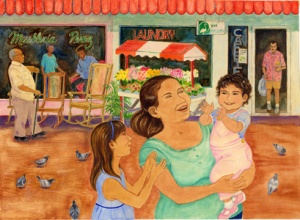What an amazing week to see the response of last Sunday’s post and hear what many of you are facing, doing, and aspiring to in schools and communities. In addition to using children’s books to initiate conversations, deepen background knowledge, and humanize the events, here are eleven teaching resources to help you provide the best information, context, and perspective for your students.
- Colorín Colorado is a free bilingual service that presents information, activities, and advice for educators and Spanish-speaking families of English Language Learners. One of my favorite sections is “Reaching Out to ELL Students and Families” because it gives explicit tools on how to create a welcoming classroom environment, learn about our students’ backgrounds, and reach out to parents of ELLs.
- Educators For Fair Consideration (E4FC) offers educator guides to support teachers and school staff in supporting undocumented students in school and beyond graduation.
- Colorlines contributes award-winning daily reporting, investigative news, and analysis on issues of race with a subsection devoted to child migrants. They also have a campaign, Drop the I-Word.
- The Library of Congress has curated thousands of resources, especially primary sources and online exhibitions, on immigration in the United States providing critical historical context to current events. I strongly recommend checking out the presentation, Immigration: The Changing Face of America, where students can read the immigration history of specific ethnicities and races, and the Themed Resources: Immigration, where students can study the contributions of American immigrants.
- The staff at the Latin American and Iberian Institute (University of New Mexico) have created and organized thematic guides, lesson plans, and news articles for issues related to Latin America available at the Latin America Data Base.
- Teaching Tolerance, a project of the Southern Poverty Law Center, provides award-winning educational materials to teachers, including immigration-themed units and lessons.
- Border Crossers has prepared a list of resources for adults to learn how to teach and talk about race and racial justice with students.
- The Migrant Policy Institute, a Washington, DC think tank, offers powerful analysis of global and regional migration. I want to underscore their visual tools, such as the International Migrant Population by Country of Origin and Destination map.
- Accompanying the two PBS documentary series, Latino Americans and The New Americans, are rich lesson plans and activities for grades 7 and up to explore the diverse experiences of coming to America.
- Latin@s in Kid Lit has an extensive list of children’s literature for those looking for more beyond our eleven book list, as well as interviews and teaching ideas.
- The MY HERO Project enables students to create, share, and discover stories, audio, art, and films that promote tolerance, peace, and diversity. Teacher resources are available at MY HERO Teacher’s Room.
- 11 Books on Latin American Immigration and Migration
- Fact Sheet from Education Department explains state and district legal obligation to help migrant children and provide them with a public education
What resources would you add? What resources do you recommend? Please share them with our community in the comments!
 Jill Eisenberg, our Resident Literacy Expert, began her career teaching English as a Foreign Language to second through sixth graders in Yilan, Taiwan as a Fulbright Fellow. She went on to become a literacy teacher for third grade in San Jose, CA as a Teach for America corps member. She is certified in Project Glad instruction to promote English language acquisition and academic achievement. In her column she offers teaching and literacy tips for educators.
Jill Eisenberg, our Resident Literacy Expert, began her career teaching English as a Foreign Language to second through sixth graders in Yilan, Taiwan as a Fulbright Fellow. She went on to become a literacy teacher for third grade in San Jose, CA as a Teach for America corps member. She is certified in Project Glad instruction to promote English language acquisition and academic achievement. In her column she offers teaching and literacy tips for educators.




Great list of resources, Jill! On behalf of the UNM Latin American & Iberian Institute, we’re honored to be included.
Thank you for including Latin@s in Kid Lit!
Hi Keira-
Thank you to LAII for creating such rigorous and engaging education resources for teachers about issues related to Latin America! LAII’s staff and partners are doing important work and we hope highlighting these efforts helps educators feel greater support on how to teach current events, history, and culture.
I can’t believe I’m just now seeing this reply! Thanks again, Jill!! We’re glad to contribute to this broader conversation and connect with amazing people like you and your colleagues!
Hi Cindy-
Latin@s in Kid Lit is such a treasure and we know that schools and families are interested in such a robust list of children’s literature and book resources! These provide and develop knowledge of Latin America and Latino/a experiences in the U.S. We wanted to offer educators a wide range of options to fit their classroom and curriculum needs and aspirations.